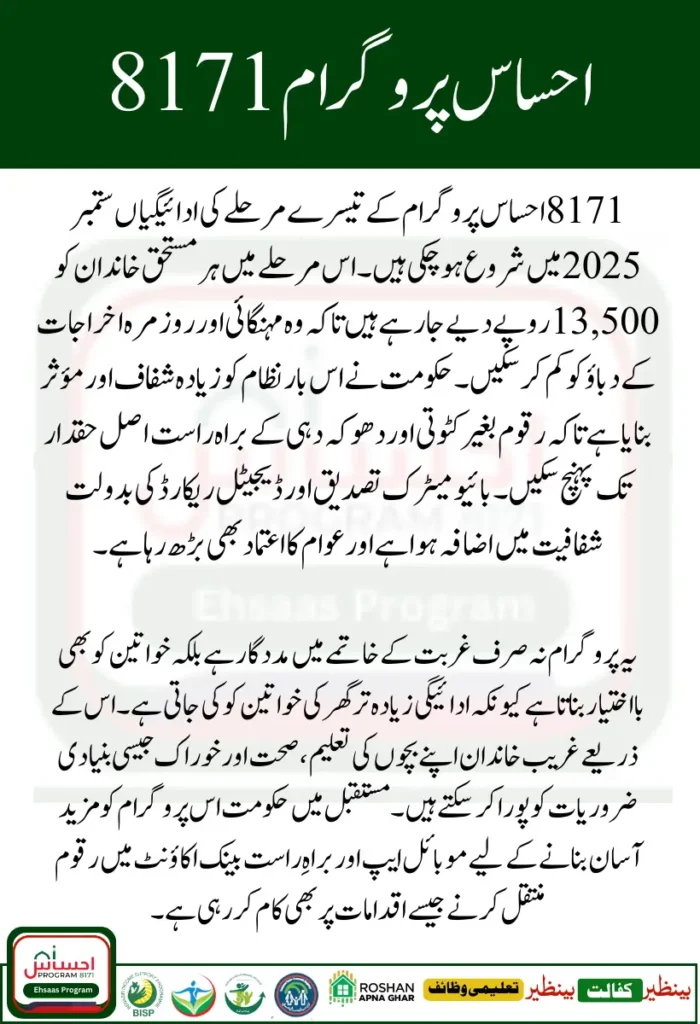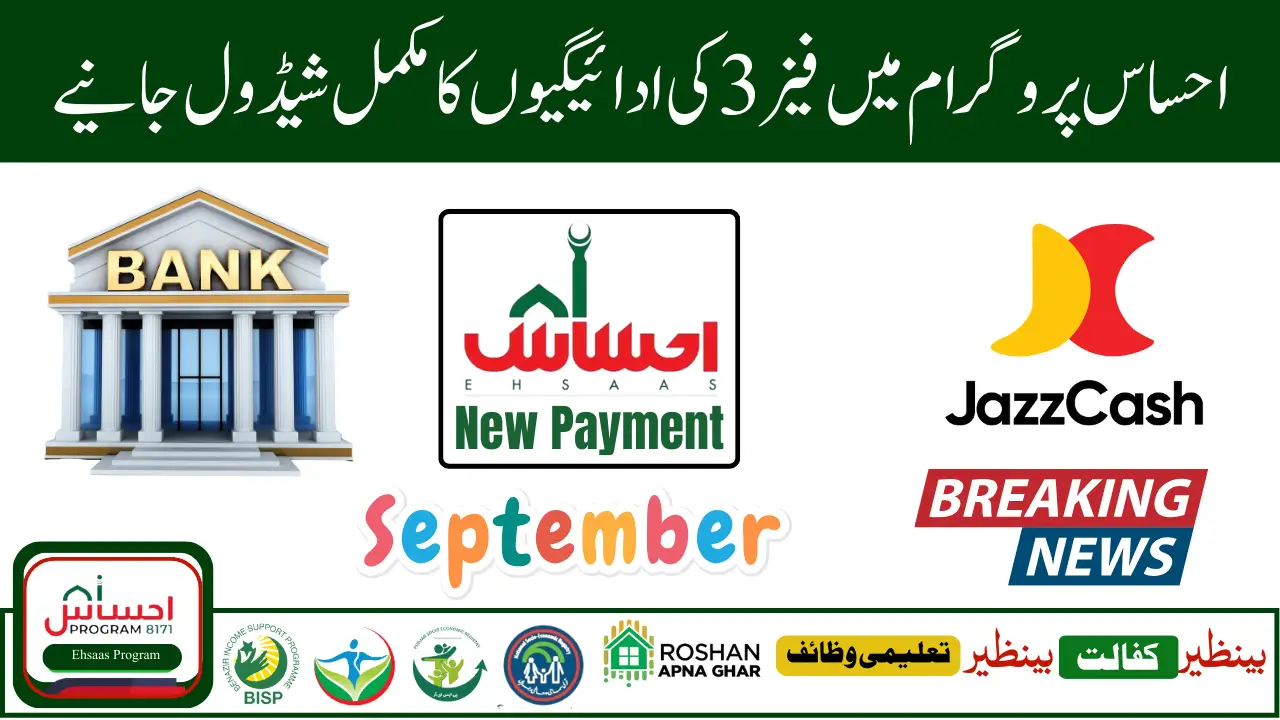The Government of Pakistan has launched 8171 Ehsaas Program Phase 3 Payments in September 2025, offering Rs. 13,500 to eligible families. Discover the comprehensive process, eligibility criteria, payment options, and strategies to prevent fraud in this comprehensive guide.

8171 Ehsaas Program Phase 3 Payments
The Government of Pakistan has officially initiated 8171 Ehsaas Program Phase 3 payments starting in September 2025. Under this phase, each qualifying family will receive Rs. 13,500 as financial support. The scheme comes at a crucial time when rising inflation has made it harder for low-income households to cover basic needs like food, education, and healthcare.
Unlike earlier installments, Phase 3 has been designed with improved transparency, ensuring payments are made without deductions, fraud, or unnecessary delays. By using a digitized, transparent, and biometric-based system, the government is building trust among citizens while ensuring that assistance reaches the right people on time.
Key Highlights of Ehsaas Phase 3 Payments
Before moving to the detailed process, here are the essential points beneficiaries should remember:
- Installment amount: Rs. 13,500 per family
- Start date: First week of September 2025
- Eligibility check: Send CNIC to 8171 or use the official web portal
- Payment collection points: Ehsaas cash centers, HBL ATMs, and authorized cash shops
- Helpline: 0800-26477 for complaints and queries
Keeping these basics in mind can help beneficiaries save time and avoid confusion during payment collection.
Payment Amount and Schedule – When and Where Payments Are Released
The government has announced that each eligible household will receive a fixed installment of Rs. 13,500 under Phase 3. Payments started in the first week of September 2025 and will continue throughout the month in a phased rollout system.
- Initially, payments are released in major cities where registration levels are high.
- In the next stage, smaller towns and rural areas are covered.
- Finally, pending or special verification cases are cleared.
This phased strategy prevents overcrowding at banks and cash centers, ensuring that rural beneficiaries are not left behind.
Who Qualifies for Ehsaas Program Phase 3?
Eligibility remains the backbone of the Ehsaas Program. The government has set strict rules to ensure that only deserving households benefit. Data verification is done through NADRA and earlier registration records.
Basic Eligibility Criteria:
- Household income must be below the official poverty line.
- No family member should be employed in government service.
- Families owning large properties or assets are excluded.
- Women already registered in earlier phases remain part of the program automatically.
This system ensures fairness and consistency in distributing financial support.
How to Check Eligibility – SMS and Web Portal
Beneficiaries can easily check their eligibility through two main options:
SMS Method
- Send your 13-digit CNIC number to 8171.
- You will receive a confirmation message about your eligibility and payment status.
Web Portal Method
- Visit the official Ehsaas 8171 portal.
- Enter your CNIC number and the security code.
- View eligibility status and payment details.
Pro tip: Always keep the confirmation SMS safe for future reference and only visit collection points after confirmation.
Where and How Payments Can Be Collected
The government has set up multiple channels to make payment collection convenient:
- Ehsaas Payment Centers – Available nationwide with biometric verification.
- HBL Partner ATMs – Quick withdrawals for urban beneficiaries.
- Authorized Cash Shops – Located in rural and small-town areas.
Every beneficiary must bring their original CNIC for biometric verification. Payments are issued instantly once verified, and no deductions are allowed. Always demand a printed receipt as proof of payment.
Required Documents for Smooth Collection
Many people face delays because they forget essential documents. To avoid issues, bring the following:
- Original CNIC
- Confirmation SMS from 8171
- B-Form (if required for family verification)
- Any official token/slip issued during scheduling
By preparing these documents, the process becomes faster and hassle-free.
Common Problems and Their Solutions
Despite improvements, some beneficiaries face technical or verification-related issues. Here are the most common problems and solutions:
- Portal not responding: Try checking during non-peak hours.
- Incorrect CNIC entry: Double-check digits before sending SMS.
- Pending verification cases: Visit NADRA to update CNIC records.
- Unlawful deductions: Report immediately via 0800-26477 helpline.
By following these solutions, beneficiaries can minimize problems and secure their payments smoothly.
Preventing Fraud and Staying Safe
The government continues to emphasize fraud prevention and transparency. Beneficiaries should stay alert and only rely on official sources.
Safety Tips:
- The official SMS code is 8171 – ignore messages from other numbers.
- Never share CNIC copies with strangers.
- Always verify payment status on the official web portal.
- Keep transaction receipts safe for record-keeping.
- Report any suspicious activity directly to the helpline.
Impact of Phase 3 Payments on Families
For many low-income households, the Rs. 13,500 installment is a lifeline. Families use it to:
- Purchase groceries and basic food items
- Pay utility bills
- Cover children’s school expenses
- Arrange medical treatment and medicines
By directing payments mainly to women, the program strengthens their role in household decision-making. This ensures the funds are spent responsibly on family needs like children’s health and education.
Future Improvements in Ehsaas Program
The government has hinted at further improvements to the system in upcoming phases. Planned updates include:
- A mobile application for real-time tracking of payments
- Faster verification and processing for pending cases
- Direct transfer of funds into beneficiaries’ bank accounts
These upgrades will make the program more efficient, reduce waiting times, and strengthen Pakistan’s largest social safety net.
Conclusion
The launch of 8171 Ehsaas Program Phase 3 payments in September 2025 marks another significant step in Pakistan’s fight against poverty. With each Rs. 13,500 installment, millions of families are able to meet essential needs despite rising inflation.
Beneficiaries should check their eligibility through 8171 SMS or the official portal, carry their CNIC and confirmation SMS for payment collection, and report any unlawful deductions. By staying alert and following the process step by step, families can receive full benefits without problems.The Ehsaas Program continues to evolve with stronger systems, broader coverage, and better safeguards—making it one of the most impactful welfare initiatives in Pakistan.
FAQs
How much money is given in Ehsaas Program Phase 3?
Each eligible family receives Rs. 13,500 in the September 2025 installment.
How can I check if I am eligible for the payment?
You can send your CNIC number to 8171 via SMS or check through the official Ehsaas 8171 portal.
Where can I collect my payment?
Payments can be collected from Ehsaas cash centers, HBL ATMs, or authorized cash shops after biometric verification.
What should I do if someone deducts money from my payment?
You should immediately call the helpline 0800-26477 and report the unlawful deduction.
Disclaimer
⚠️ Disclaimer: This article is for informational purposes only. We are not affiliated with any government agency. For official updates, visit the official BISP website.
Note: This content is based on publicly available information. We are not affiliated with BISP or any government body. Read full disclaimer here.
